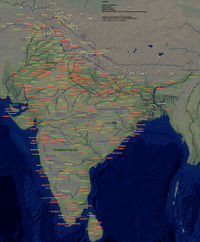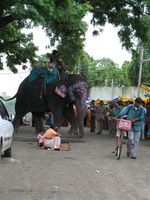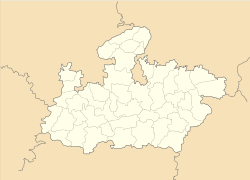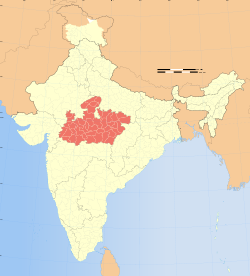Ujjain
| Ujjain | |
| — city — | |
|
|
|
| Coordinates | |
| Country | |
| State | Madhya Pradesh |
| District(s) | Ujjain |
| Population | 429,933 (2001[update]) |
| Time zone | IST (UTC+5:30) |
| Website | ujjain.nic.in |
Ujjain (Hindi: उज्जैन) pronunciation (also known as Ujain, Ujjayini, Avanti, Avantikapuri), is an ancient city of Malwa region in central India, on the eastern bank of the Kshipra River (Hindi: क्षिप्रा), today part of the state of Madhya Pradesh. It is the administrative centre of Ujjain District and Ujjain Division.
In ancient times the city was called Ujjayini. As mentioned in the Mahabharata epic, Ujjayini was the capital of the Avanti Kingdom, and has been the Prime Meridian for Hindu geographers since the 4th century BCE. Ujjain is one of the seven sacred cities(Sapta puri) of the Hindus, and the Kumbh Mela religious festival is held there every 12 years. It is also home to Mahakaleshwar Jyotirlinga, one of the twelve Jyotirlinga shrines to the god Shiva and is also the place where Lord Krishna got education with Balarama and Sudama from Maharshi Sandipani.
Contents |
History of Ujjain


The earliest references to the city, as Ujjaini, are from the time of the Buddha, when it was the capital of the Avanti Kingdom. Since the 4th century B.C. the city has marked the first meridian of longitude in Hindu geography. It is also reputed to have been the residence of Ashoka (who subsequently became the emperor), when he was the viceroy of the western provinces of the Maurya empire.
In the Post-Mauryan period, the city was ruled by the Sungas and the Satavahanas consecutively. It was contested for a period between the Satavahanas and the Ror Sakas (devotees of Shakumbari), known as Western Satraps; however, following the end of the Satavahana dynasty, the city was retained by the Rors from the 2nd to the 4th century CE. Following the enthroning of the Gupta dynasty, the city soon became an important seat in the annals of that empire. Ujjain is considered to be the traditional capital of King Chandragupta II, also known as Vikramaditya, at whose court the nine poets known as the navaratna (nine jewels) of Sanskrit literature are said to have flourished.
In the 6th and 7th centuries, Ujjain was a major centre of mathematical and astronomical research. The famous mathematicians who worked there included: Brahmagupta, whose book Brahmasphutasiddhanta was responsible for spreading the use of zero, negative numbers and the positional number system to Arabia and Cambodia; Varahamihira, who was the first to discover many trigonometric identities; and Bhaskaracharya, or Bhaskara II, whose book Lilavati broke new ground in many areas of mathematics.
Ujjain was invaded by the forces of the Delhi Sultanate led by Iltutmish in 1235, suffering widespread destruction and systematic desecration of temples. Under the Mughal emperor Akbar it became the capital of Malwa.
During the last half of the 18th century Ujjain was the headquarters of the Maratha leader Scindia. The Scindias later established themselves at Gwalior, and Ujjain remained part of Gwalior state until Indian Independence in 1947. Gwalior state became a princely state of the British Raj after the Maratha defeat in the Third Anglo-Maratha War, and Gwalior, Ujjain, and the neighboring princely states were made a part of the Central India Agency. After Indian independence, the Scindia ruler of Gwalior acceded to the Indian Union, and Ujjain became part of the Madhya Bharat state. In 1956 Madhya Bharat was merged into the Madhya Pradesh state.
Ancient monuments and tourist sites in Ujjain
- The Mahakal Temple, one of the twelve Jyotirlingas, is a famous and venerated Shiva temple. The Shivling in this temple is supposed to be the only Jyotirling which faces south and hence it is known as Dakshinmukhi or the south-facing ling. It is the most popular and important temple of Ujjain. Every year on shivratri (claimed to be the Birthday of Lord Shiva), there is a huge crowd of devotees for darshan. The same kind of public crowd can be seen in the month of Savaan, NagPanchami. On every Monday of "Savan", there is a huge procession for the Lord Shiva idol in the city attended by large numbers of devotees from across the India.
- Mahakal derives its name from "kaal" meaning end of life - death; the word Mahakaal means Lord of Death.
- Sri Sri Radha Madan Mohan Temple, of the ISKCON (International Society for Krishna Consciousness) or Hare Krishna Movement, also has a guest house and restaurant, and is a major attraction for tourists, though it is very new on the map of Ujjain.
- The temple of Chintaman Ganesh is the biggest ancient temple of Lord Ganesha in Ujjain.
- The temple of Maa Wagheshvari is known for its tall idol of the goddess Wagheshwari and "Sinh (lion) - Dwar (gate)".
- The Harsidhhi Temple is one of the Shaktipeeth, situated at 52 places in India.
- The Sandipani Ashram is where tradition says Shri Krishna was educated with Balarama and Sudama from Maharshi Sandipani.
- The Siddha Ashram, located between Ramghat and Narshinghat, is known for research in Ayurvedic medicine and Kundalini Shaktipat.
- The Kaliyadeh Palace, located on the outskirts of the city, is one of the palaces belonging to royal Scindia family of Madhya Pradesh.
- The Bhrathari caves is an ancient site which has some interesting legends associated with it.It is said that it holds tunnels which lead directly to 4 ancient dhams (char dham).these ways were later shut down by britishers.
- The Observatory (Vedha Shala) built by a Rajput king, Raja Jai Singh II, in the 1720s, is one of the five such observatories in India and features ancient astronomical devices.
- The Prashanti Dham is a holy place, where Sai Baba's Ashram is situated.
- Jain temples: Jai Singh Pura Atishay Kshetra, Tapobhoomi, Avanti Parshwanath, Hanumant baag,Manibhadradham Bhairavgarh.
- The Kothi Palace presents a sight worth watching in the evening.
- The Bharatiya Vidya Bhavan museum, located near Chamunda tower, holds many ancient objects.
- The throne of Maharaja Vikramaditya, known as the "seat of judgment (salabanjika throne)" may be located in the Rudra Sagar lake.
- Other temples are Harsidhhi (Durga Temple), Gadh Kalika, Kaal Bhairav, Triveni (Nav Graha Shani Mandir), Mangalnaath, Siddhhanath and Shiv Shakti.
Image gallery
|
Mahakal Temple Ujjain |
Kalabhairava Temple Ujjain |
Mahakal Jyotirlinga Ujjain |
Bhadrakali Temple Ujjain |
 Sri Sri Radha Madan Mohan Temple, ISKCON Ujjain |
 Sri Sri Krishna Balram, ISKCON Ujjain |
 Sri Sri Radha Madan Mohan Temple, ISKCON Ujjain |
 Sri Sri Radha Madan Mohan, ISKCON Ujjain |
Various Names of Ujjain
Since Ujjain is one of the oldest cities in India, it has been known by many names:[1]
- Avantika
- Padmavati
- Kushasthali
- Bhagavati
- Haranyavati
- Kandakatringa
- Kumudvati
- Pratikalpa
- Ujjayani
- Udeni
- Vishala
It is said that to the Western astronomers it was known as "Arin".
Geography
Ujjain is situated on the Malwa Plateau in Central India. The soil is black and stony. The vegetation is typical of arid regions with thorny trees like babul and acacia dominating the landscape. Soybean, wheat, jowar and bajra are the main crops grown.
Ujjain is located at .[2] It has an average elevation of 491 metres (1610 ft).
Demographics
As of 2001[update] India census,[3] Ujjain had a population of 429,933. Males constitute 52% of the population and females 48%. Ujjain has an average literacy rate of 72%, higher than the national average of 59.5%: male literacy is 79%, and female literacy is 66%. In Ujjain, 13% of the population is under 7 years.
Climate
Ujjain experiences typical climate conditions of the interior Indian subcontinent. The summer months (April–June) are harsh with temperatures reaching up to 45°C. In addition, hot winds (called loo) may blow in the afternoons, worsening the heat. The winter months (Nov.–Feb.) are pleasant and cool with daytime temperatures typically 20°C, though it may drop to subzero in the night. The monsoon typically arrives in late June and the months of June till September receive moderate to heavy rainfall. There are periods of rainfall followed by long periods of bright sunshine and high humidity. The month of October generally is very warm and with high humidity.
Administrative
Ujjain city has two legislative assembly zones, known as Ujjain North and Ujjain South. For Parliamentary purposes it is treated as one seat
Economy
The economy of Ujjain is mainly dependent on the agricultural activities of the nearby villages. Two main crops are grown each year: wheat as the major Rabi crop, soybean as the major Kharif crop. Ujjain agriculture is sensitive to changes in rainfall and failure of monsoon cycles can lay a devastating toll on agriculture and the local economy.
Ujjain was previously a centre of the textile industry with a number of textile mills in and around the city. Most of the mills have since closed. Religious tourism is also a contributor to the economy, especially during the Simhasta Mela.
A number of new infrastructure projects are under construction. Major investments are planned by some of the leading companies in steel sector (like SAIL) to utilize Ujjain as a base for regional supply. With cheaper land & labour costs Ujjain is creating enough attention for new investments.
Ujjain also generates huge revenue from the boost given to the economy by the holy fair of Kumbh Mela locally known as Simhastha.
Transport

Ujjain is well-connected by rail, air and road. It is on the Western Railway and is connected by direct train to most major Indian cities.Ujjain has an air strip. The nearest airport is Indore Airport.The road network is developed with other parts of Madhya Pradesh.Ujjain is connected to Indore through SH-27 and SH-18 Dewas-Badnawar passes through it.
Railway Stations
There are three railway stations:
- Ujjain Junction main
- Vikram Nagar
- Chintaman (Metre Gauge)
- Pingleshwar
Bus Stations
- Dewas Gate(main bus stand)
- Nanakheda
Major Roads
Indore Road, Dewas Road, Agar Road, Badnagar Road, Maksi Road, Nagda Road.
Education
Primary and secondary education in Ujjain is offered by various schools which are affiliated to either Madhya Pradesh Board of Secondary Education or CBSE.
Ujjain is well known for its university, Vikram University which is the second oldest university in Madhya Pradesh,established in 1957. The city has one Government aided Engineering College Ujjain Engineering College (UEC) and numerous privately run Engineering and Management institutes. Medical Colleges include Government aided Govt. Autonomous Dhanvantri Ayurveda College & privately held R.D.Gardi Medical College.
84 Mahadeva (Shiva) of Ujjain
There are 84 Gods of Ujjain, Chaurasi Mahadev (Shiva), out of them four are the dwarapalas of Mahakala Ujjain. The four dwarapalas are Pingaleshwara (East), Kayavarohaneshwara (South), Vilveshwara (West) and Dardareshwara (North). The Chaurasi Ishwaras are:
Agasteshwara Mahadeva, Gurihashwara Mahadeva, Dudeshwara Mahadeva, Damarukeshwara Mahadeva, Anadikalpeshwara Mahadeva, Swarnajaleshwara Mahadeva, Trivishtapeshwara Mahadeva, Kapaleshwara Mahadeva, Swargadareshwara Mahadeva, Karkoteshwara Mahadeva, Siddheshwara Mahadeva, Lokapaleshwara Mahadeva, Kameshwara Mahadeva, Kutumbeshwara Mahadeva, Indradhamneshwara Mahadeva, Ishaneshwara Mahadeva, Apsareshwara Mahadeva, Kalakaleshwara Mahadeva, Nagachandreshwara Mahadeva, Pratihareshwara Mahadeva, Kukkuteshwara Mahadeva, Karkateshwara Mahadeva, Meghanadeshwara Mahadeva, Mahalayeshwara Mahadeva, Mukteshwara Mahadeva, Someshwara Mahadeva, Anarkeshwara Mahadeva, Jateshwara Mahadeva, Rameshwara Mahadeva, Chyavaneshwara Mahadeva, Khandeshwara Mahadeva, Pantaneshwara Mahadeva, Anandeshwara Mahadeva, Kandhadeshwara Mahadeva, Indreshwara Mahadeva, Markandeshwara Mahadeva, Shiveshwara Mahadeva, Kusumeshwara Mahadeva, Akrureshwara Mahadeva, Kundeshwara Mahadeva, Lumpeshwara Mahadeva, Gangeshwara Mahadeva, Angarakeshwara Mahadeva, Uttareshwara Mahadeva, Trilochaneshwara Mahadeva, Vireshwara Mahadeva, Nripareshwara Mahadeva, Abhayeshwara Mahadeva, Prithukeshwara Mahadeva, Sthawareshwara Mahadeva, Shuleshwara Mahadeva, Onkareshwara Mahadeva, Vishvareshwara Mahadeva, Kantheshwara Mahadeva, Singheshwara Mahadeva, Revanteshwara Mahadeva, Ghanteshwara Mahadeva, Prayageshwara Mahadeva, Shrisiddheshwara Mahadeva, Matangeshwara Mahadeva, Saubhageshwara Mahadeva, Rupeshwara Mahadeva, Sahastradhanukareshwara Mahadeva, Pashupateshwara Mahadeva, Brahmeshwara Mahadeva, Jalapeshwara Mahadeva, Kedareshwara Mahadeva, Pishachamukteshwara Mahadeva, Sangameshwara Mahadeva, Duddhareshwara Mahadeva, Yageshwara Mahadeva, Chandradityeshwara Mahadeva, Karabheshwara Mahadeva, Rajasthaleshwara Mahadeva, Badaleashwara Mahadeva, Aruneshwara Mahadeva, Pushpadanteshwara Mahadeva, Abhimukteshwara Mahadeva, Hanumanteshwara Mahadeva, Shriswapneshwara Mahadeva, Pingaleshwara Mahadeva, Kayavarihaneshwara Mahadeva, Bilkeshwara Mahadeva, Durdureshwara Mahadeva,
References
- ↑ Room A. Placenames of the world: origins and meanings, p. 12.
- ↑ Falling Rain Genomics, Inc - Ujjain
- ↑ "Census of India 2001: Data from the 2001 Census, including cities, villages and towns (Provisional)". Census Commission of India. Archived from the original on 2004-06-16. http://web.archive.org/web/20040616075334/http://www.censusindia.net/results/town.php?stad=A&state5=999. Retrieved 2008-11-01.
External links
- Official website of Ujjain
 This article incorporates text from a publication now in the public domain: Chisholm, Hugh, ed (1911). Encyclopædia Britannica (Eleventh ed.). Cambridge University Press.
This article incorporates text from a publication now in the public domain: Chisholm, Hugh, ed (1911). Encyclopædia Britannica (Eleventh ed.). Cambridge University Press.
|
||||||||||||||||||||||
|
||||||||||||||||||||||||||

